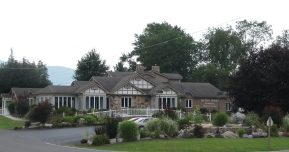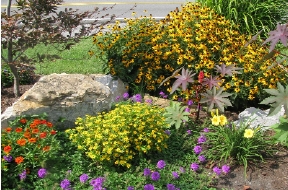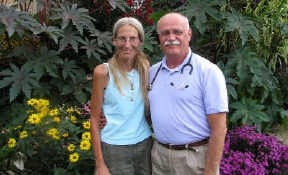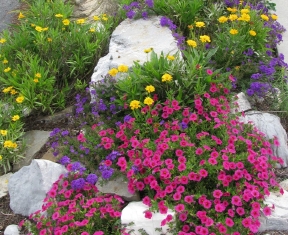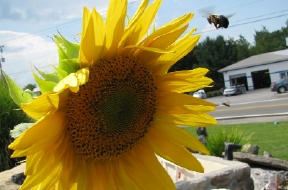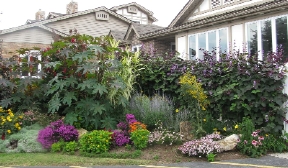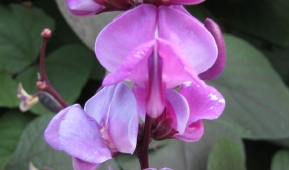
|
|
|
|
|
|
|
|
|
|
|
|
|
|
|
Feature Stories:
Equine sculptor’s fine detail
brings large horses to life
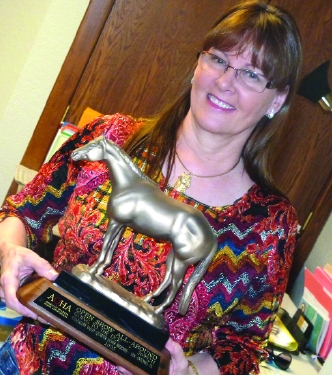
By Lisa Perry
Around Town Magazine, March 25, 2012
Cooke County resident and artist Marrita
Black has her sculptures displayed throughout the world. Living
in this area since the early eighties, she specializes in
bronze sculptures of horses and riders. Some of her creations
are larger than life size. She has converted the barn into
a studio at the ranch where she lives with her husband Bob
Black, three canaries, a number of Chinese Crested dogs,
various other dogs, several donkeys, and some beautiful horses.
Marrita stands in front of her current
project, a larger than life oil based clay sculpture of a horse
called "The Sire," which will eventually be cast in
bronze. She refers to some extensively used laminated diagrams
of the muscle and bone structure from a horse anatomy book.
"You need to understand the complexities of the structure
underneath the skin of the horse to sculpt it
realistically," she said. "You have to know there is
a bone here and a muscle there in order to form the shape of
the body and face correctly." And she does understand it.
Her mother claims that she said
"horse" before she could speak any other words.
Growing up near Kansas City, she had her first pony by the time
she was eleven or twelve. By the time she was in high school
she was being accused of tracing pictures instead of drawing
them because her work was so intricately detailed. She just
wanted everything to be as "perfect" and realistic as
possible and she had a flair for attention to specifics. She
got a degree in animal science in college, and she helped to
pay for her education by modeling for pictures with horses.
"That's what I wanted to do anyway," she said
smiling. "I wanted to be with the horses and go to the
shows, and I could learn a lot by watching the people and the
horses there." She went on to show her own quarter
horses quite successfully, and she built a respectable
reputation and wide acclaim within that circle for many
years.
In the early nineties, she traveled with
a friend to Sante Fe, New Mexico and was inspired by the art
there. She noticed that the art was mostly focused on Native
Americans and cowboys "of the old days." She also
noticed that there wasn't much attention given to the modern
day cowboys and cowgirls and horses. That was when it occurred
to her to put her focus there. She began sculpting when she got
home from that trip, and she hasn't stopped since then. It was
a perfectly natural progression from her contacts and acclaim
within the horse show circles to her art representing that
lifestyle. People were anxious to see her work, and as soon as
they did, the commissions began to abound. When people saw the
beauty and immaculate detail of her sculptures, they wanted
their horses and loved ones to be preserved in bronze forever
in one of her creations. And word spread like wildfire.
Marrita has numerous commissioned
sculptures that can be seen in this area. There is a large
piece in front of the American Paint Horse Association office
in Fort Worth. It consists of four 125% life size paint horses.
"To create this monument I sculpted a 1/3 size
marquette in clay," she states on her website. "A
model was created from the 1/3 size maquette. Using that small
model, the larger horses were sculpted." It was a long
process from the clay sculptures through multiple rubber, wax
and ceramic molds and steps to get the pieces to the stage
where they were ready to be cast in bronze. The process is both
artistic and scientific involving molten metal and caustic
chemicals. And even then, there were still many more steps to
weld the pieces together and to get the bronze colored,
polished and preserved. This huge piece, called “Legacy
of Color,” was commissioned in 2000, and the finished
sculpture weighs approximately 3 tons. It took two years to
complete the project.
She has a sculpture at the American
Quarter Horse Hall of Fame and Museum in Amarillo that depicts
Carol Harris and her legendary 2 time AQHA world show Champion
“Rugged Lark.” Carol Harris was inducted into that
Hall of Fame in 1997. The bronze statue stands in front of the
Hall of Fame and was commissioned and donated by Carol Harris.
Another copy resides at her home in Florida.
Marrita has also created sculptures of
people. Indu is a sculpture of a kind and well-respected
Chemical Engineering PhD. The sculpture was commissioned by her
husband after she passed away. “It is 6 feet and 2 inches
tall, standing larger than life size and is composed of over
150 pounds of clay,” says the artist. This piece will
stand in three different areas in Tulsa, OK when completed, and
one piece will be transported to India to be displayed there.
Marrita is also working on a piece that
will hang on the upper wall of a library in a mansion in
Arizona. The sculpture is in the form of a life size horse that
will appear to be jumping through the wall. Marrita said the
piece will have to be made of a much lighter weight substance
than bronze in order to hang on the indoor wall. It will be
finished in soft colors to depict a white horse with dappled
grey undertones.
"Horses are as individual as people
are," Marrita said intently. "When you spend time
around them, or study their pictures, their personalities and
spirit come to light. I try to incorporate that into the art.
They all have different expressions and a certain way of
carrying themselves. Each one is unique, and it is very
important to portray that."
Not all of Marrita's sculptures are
massive. She has a gallery of room-sized sculptures for
the home as well. These are numbered edition fanciful pieces of
horses, some including people riding on or standing with them.
Her favorite is displayed in the center of her living room. It
is called "Looking Good" and depicts a cowboy riding
in a horse show sitting tall on his horse. It is from a 14
piece edition that has now sold out. The detail in the clothes
and saddle are truly delightful. The piece stands 38 x 34 x
12.5 inches. “Looking Good” also resides and
can be viewed at the Spirit of the West Resort in Tioga.
Marrita creates sculptures of her beloved
Chinese Crested dogs, too. Another of her passions, she has
bred and shown these animals with championship
results.
One of her newer endeavors has been the
development of a line of home decor products made of a special
resin which she gets right here in Texas. These are all
handcrafted items, but are made of resin rather than bronze.
They are lighter, smaller, open edition pieces and therefore
much less expensive. These products range anywhere from
fountains and large plant containers to vases, jewelry boxes,
picture frames, medallions, crosses and small sculptures all
decorated with horses. She also has designed bronze horse door
handles and doorknobs. Many of these pieces have been carried
by Bed, Bath and Beyond, The Potpourri House, and Schneiders
Western Store.
You can view Marrita's art and contact
her on her web site at www.Marrita.net.
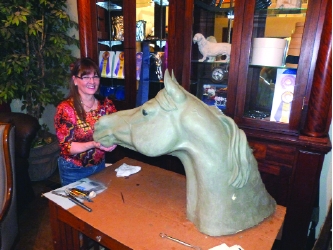
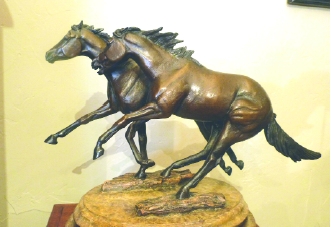
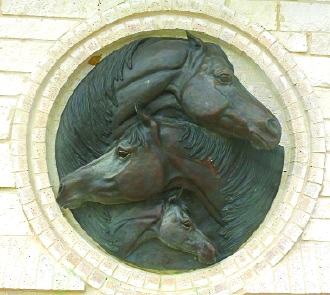
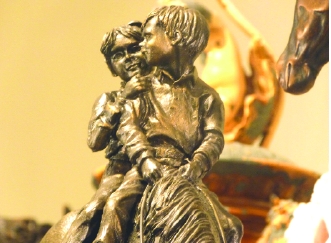
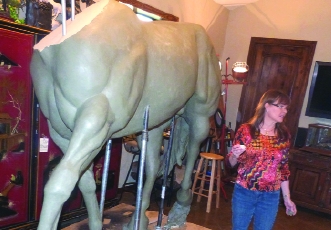
By Lisa Perry
The Southwest Times, Pulaski, Va Sept.
24, 2009
It is difficult not to notice Tipton
Ridge Veterinary Medical Center as you drive by it on Bob White
Boulevard. The building and garden attract your eyes and senses
with their aesthetic and joyful allure. The customers enjoy it
as they bring in their dogs, cats, birds and other animals for
Dr. Randy Vaughn’s care. Some people can’t
resist pulling into the parking lot just to look around, take
pictures, maybe ask a few questions, and to breath in the air
of the well-crafted, peaceful space.
The building itself is an admirable sight
with its tutor eaves, rock façade, and multi-faceted
roofline reflecting the ridgeline of Peaks Knob, which towers
behind it. Randy began construction of it in 1980 with his
father and brother Mark. The original building was much more
rectangular and straight-roofed, and Randy did the original
rockwork himself. But he knew that was not the vision that he
had for his veterinary office, so he remodeled it, also with
the help of his brother, from 1999 through 2003. He named the
center Tipton Ridge in honor of his father whose middle name
was Tipton and who passed that name down to his son.
Randy had an early affinity for plants,
especially the blooming varieties, and remembers how his
parents and grandparents encouraged and helped develop that
quality in him. They all had gardens, and he smiles as he
speaks of how his mother always had many things blooming in
hers. Staying active and involved in nature was a way of life
for his family, and so his thoughts turned to the landscaping
around the clinic.
He wasn’t sure exactly how to begin
until, in a flash of inspiration, he suddenly realized that he
wanted rocks…big rocks…everywhere. So he brought in
a large variety of sizes of limestone and placed them around
the property. Then he planted a few raspberry crepe myrtles and
some Crimson King maple trees.
Beth Gartner had been taking her animals
to Dr. Vaughn’s clinic for years. They were good friends
and he knew she would be the perfect solution for taking his
landscaping to the next level. Thus began their partnership in
creating the garden there in January of ’07.
Beth is well known in this area for her
plant knowledge and expertise in gardening. She was the
landscape specialist at New River Community College for many
years. She has a degree from Virginia Western Community College
in Roanoke and absorbed every horticulture class they had. She
worked on the grounds at NRCC, and with the help of some grants
from the forestry service, she designed and implemented a
Learning Gazebo. It was highly successful and unique, and she
taught various classes there as well.
Beth’s love of plants started at a
very early age. By the time she was six years old, she already
had cultivated her own rock garden. Even as a child, she began
writing down combinations of plants in a diary. She has
accumulated several of those diaries that span ten years each,
and she still uses them as references for her ideas.
She, too, was blessed with grandparents
on both sides who loved gardening and helped to encourage her
talents in that area. Her paternal grandparents had a formal
garden in Swarthmore, Pennsylvania, and she particularly
remembers their beautiful iris. Her mother and maternal
grandparents were Pulaski residents, and they had a house with
a conservatory. Beth remembers a Night Blooming Cereus plant
there. When it would be ready to bloom, her grandmother would
host a midnight tea party in celebration to watch the flowers
open.
Beth has a wonderful sense for color,
texture, light and combination. She also has a talent for
finding unusual and striking shapes and sizes of leaves and
flowers, and incorporating them into her designs. Her ability
to visualize and her unique combinations truly elevate her
gardening to an art form.
Randy and Beth started the project by
bringing in truckloads of very good, enhanced dirt, which they
both believe is the cornerstone of any successful garden. Then
Beth began to plant a few Japanese maples, forest pansy redbuds
and Black-eyed Susans. Randy designed the unusual nonlinear
fence for the property, which allows for alternate planting and
viewing from both sides.
The garden includes a pond on the side of
the building, which is surrounded by plume poppies, a very
unusual variety that makes a strong structural statement in
combination with tall grasses and Japanese maples. Not far away
is a purple smoke bush, various varieties of verbena, tansy,
Japanese anemones, purple leaf sedum, coreopsis rosea and
threadleaf coreopsis, Johnson’s Blue geraniums,
euphorbia, Arkansas blue star, a variety of asters, blue
plumbago, rocket ligularia, Russian sage, and daylilies. There
are several types of sunflowers lining the parking lot,
including Russian giant, Mexican, and a variety that has a dark
maroon bloom. There are numerous types of grasses, including
zebra, variegated myscanthus, and sedge.
Seeds must be started for several of the
crowning glories of the garden every year. Purple hyacinth bean
vines adorn the fence, and the towering castor bean plants with
their giant leaves and striking red blooms must be propagated
each spring.
All in all, this garden provides a rich
and soothing background where each plant can be enjoyed
individually as well.
